In the quiet, remote village of Kamimomi, nestled in Japan's western Okayama prefecture, the serene beauty of ancient rice terraces contrasts sharply with the challenges faced by the rice farmers. The prefecture, often dubbed "the Land of Sunshine" for its traditionally pleasant climate, has been hit hard by the realities of climate change. For Japan's aging farmers, the struggle to maintain rice cultivation—a cornerstone of the country’s diet—is becoming an uphill battle, not only against time but also against the sweltering heat.
This year, farmers in Kamimomi began their rice harvest two weeks earlier than usual. What was once a predictable agricultural cycle is now disrupted by record-breaking temperatures. In July 2024, Japan experienced its hottest month ever recorded, with temperatures averaging 2.16°C (3.9°F) higher than normal. These soaring temperatures are a stark reminder of the global rise in temperatures, which have increased by 1.2°C (2.2°F) since preindustrial times. The impact of this rise is being felt in every corner of the world, but for Japan’s rice farmers, it is threatening not just a crop, but a cultural heritage.
Climate Change and Its Impact on Rice Production
Rice is more than just a staple food in Japan; it is deeply woven into the country's traditions and way of life. However, the increasing intensity of heatwaves poses a direct threat to the production of this vital grain. Joji Terasaka, a rice farmer in Kamimomi, shared his concerns: “Last year, an exceptional heat wave took the water out of the rice, which became small and thin. So I am worried about that this year because it will be just as hot.”
The issue is not just limited to the amount of rice produced, but also its quality. As temperatures rise above 27°C, the buildup of starch inside rice grains is reduced, leading to a chalky appearance and a significant drop in value. According to a report from Japan's farming ministry, at least 20% of rice farms have reported a decline in rice quality due to rising temperatures. As Yuji Masutomi, a researcher at the National Institute for Environmental Studies in Tsukuba, points out, “Perhaps people think that an increase of one degree Celsius in average temperature isn't much. But it's quite a big change for plants and crops.”
This subtle but significant shift in temperature has created a cascade of problems. Beyond aesthetics, the taste of rice deteriorates as well, leading to concerns not just for farmers, but for consumers who depend on rice as a dietary staple. The supply shortage caused by last year’s poor harvest led to empty supermarket shelves and the enforcement of purchase limits on rice in some areas.
The Aging Farmers of Japan: A Vulnerable Workforce
Amid this climate crisis, another factor intensifies the situation: the aging population of Japan’s agricultural workforce. With an average age of nearly 69, Japan’s rice farmers are among the oldest in the world. The labor-intensive nature of rice farming, compounded by the increasing heat, puts these elderly farmers at great risk. Heatstroke and exhaustion have become real threats as they work in paddy fields during the hottest months of the year. Mitsumasa Sugimoto, a 77-year-old rice farmer, explains, “It takes a half year to produce rice. The heat and the work that we have to endure during that time is really tough.”
As Japan’s rural areas continue to experience depopulation, many paddy fields have been abandoned, exacerbating the situation. Kamimomi’s farmers, in response, formed a community project led by Toshimi Kaiami to revive some of these fields. But the project, while noble, faces an existential crisis. “There are no longer any successors,” Kaiami says solemnly. “We are heading toward extinction.”
The work of reviving abandoned fields, while important for maintaining local rice production, is increasingly untenable as the population ages and the younger generation is either unwilling or unable to take on the burden of farming. The extreme heat is proving too much for many to endure, further discouraging potential newcomers to the profession.
Solutions in the Face of Crisis: Heat-Resistant Rice
To combat the effects of climate change, the Japanese government and research organizations have begun promoting heat-resistant rice variants. One such variety, Sai no Kizuna, developed by the Agricultural Technology Research Center in Saitama prefecture, has shown promise. Unlike the popular Koshihikari variety, which struggles under extreme heat, Sai no Kizuna has been specifically bred to withstand higher temperatures, as well as strong typhoon winds and certain pests.
“Last year and this year have been extremely hot, but even in those conditions, Sai no Kizuna maintained a certain level of quality,” says Naoto Ohoka, a manager at the center. In addition to its resilience, the new variety has a reputation for being delicious, a key factor in encouraging farmers to switch.
But change doesn’t come easily. Despite the benefits of these heat-resistant strains, adoption has been slow. Farming ministry data show that only about 15% of Japanese paddy fields have adopted these variants. Many older farmers are reluctant to switch from the Koshihikari variety, which has been a mainstay for decades.
Developing new rice variants is a long and arduous process. It can take up to 10 years to breed, test, and market a new strain. Even once a new variant is approved, convincing farmers—many of whom have spent their lives cultivating one type of rice—to change is another challenge entirely. Researchers, however, are already planning for the future, aiming to develop strains that can withstand temperatures up to 3°C higher, anticipating further climate shifts by the 2040s.
A Call to Action: The Need for Systemic Change
The struggles faced by Japan’s rice farmers offer a stark lesson in the wider implications of climate change on agriculture. As temperatures rise globally, more regions will experience disruptions to essential food crops, which could lead to food shortages, economic instability, and an even greater burden on the already strained agricultural workforce.
The introduction of heat-resistant rice variants like Sai no Kizuna is a critical step forward, but it cannot be the only solution. For Japan, and the world, to safeguard future food security, systemic changes in agricultural practices must be implemented. Governments need to provide more incentives for farmers to adopt climate-resilient crops. Further investments in research and development of such crops should be prioritized. Additionally, the aging farming population needs support—through technological innovation, younger worker recruitment, and healthcare resources for those continuing to labor in extreme conditions.
The resilience of Kamimomi’s farmers, who continue to work despite the challenges, speaks volumes about the dedication of Japan’s rural agricultural communities. But without broader systemic support and a concerted effort to mitigate the effects of climate change, their efforts may not be enough to preserve one of Japan’s most cherished staples: rice.
In the face of climate change, Japan's rice farmers are standing at the crossroads of tradition and survival. As temperatures rise and the workforce ages, the struggle to maintain this vital crop is becoming more daunting with each passing season. The world is watching, and Japan’s response may well serve as a blueprint for other nations facing similar challenges.








.jpg?auto=format%2Ccompress&fit=max&format=webp&w=768&dpr=1.0)


















